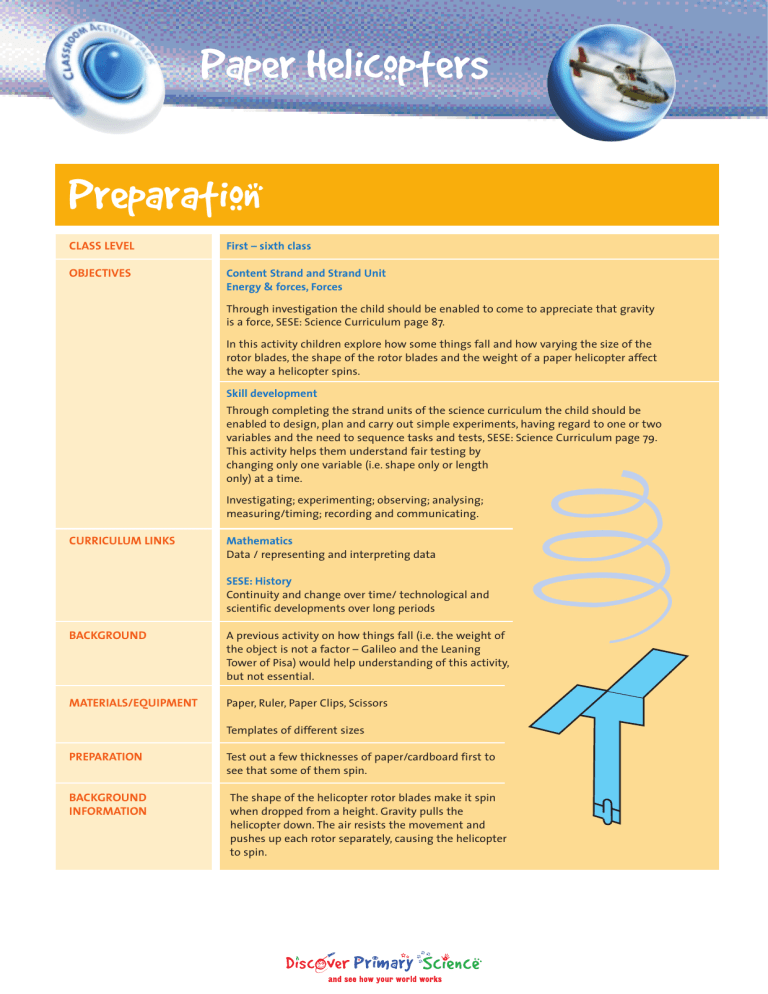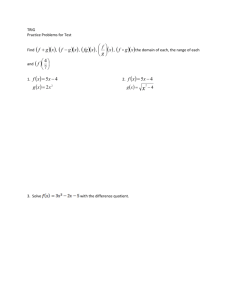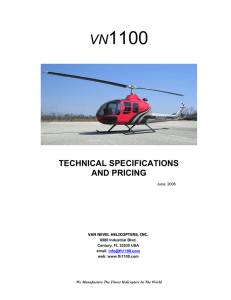Paper Helicopters

Paper Helicopters
Preparation
CLASS LEVEL
OBJECTIVES
CURRICULUM LINKS
BACKGROUND
MATERIALS/EQUIPMENT
PREPARATION
BACKGROUND
INFORMATION
First – sixth class
Content Strand and Strand Unit
Energy & forces, Forces
Through investigation the child should be enabled to come to appreciate that gravity is a force, SESE: Science Curriculum page 87.
In this activity children explore how some things fall and how varying the size of the rotor blades, the shape of the rotor blades and the weight of a paper helicopter affect the way a helicopter spins.
Skill development
Through completing the strand units of the science curriculum the child should be enabled to design, plan and carry out simple experiments, having regard to one or two variables and the need to sequence tasks and tests, SESE: Science Curriculum page 79.
This activity helps them understand fair testing by changing only one variable (i.e. shape only or length only) at a time.
Investigating; experimenting; observing; analysing; measuring/timing; recording and communicating.
Mathematics
Data / representing and interpreting data
SESE: History
Continuity and change over time/ technological and scientific developments over long periods
A previous activity on how things fall (i.e. the weight of the object is not a factor – Galileo and the Leaning
Tower of Pisa) would help understanding of this activity, but not essential.
Paper, Ruler, Paper Clips, Scissors
Templates of different sizes
Test out a few thicknesses of paper/cardboard first to see that some of them spin.
The shape of the helicopter rotor blades make it spin when dropped from a height. Gravity pulls the helicopter down. The air resists the movement and pushes up each rotor separately, causing the helicopter to spin.
Paper Helicopters
Activity
SETTING THE SCENE
TRIGGER QUESTIONS
DEVELOPMENT
OF ACTIVITY
SAFETY
ACTIVITY
When we talk of flight we can mean a number of things. Some things actually fly while others glide or float. What do these do – aeroplanes and birds, gliders and flying foxes, balloons?
Have pictures of things in flight so that children can compare and contrast.
Discuss aeroplanes – how they have to keep moving in order to stay in the air. So how do helicopters stay still in the air? (The spin of the rotor blades keeps them up.)
What do sycamore seeds do when they fall off the tree? Describe what happens.
What makes a good helicopter?
Can you make some different helicopters and decide which one is best?
What do we mean by best? Is it the one that spins the most?
Or is it the one that takes longest to fall to the ground?
THE CHILDREN CAN DECIDE WHICH.
Drop different things from a height and observe how they fall. Dropping flat pieces of paper and scrunched-up pieces could set the scene.
Care to be taken if children stand up on chairs/stools in order to drop the helicopters from a greater height.
Begin by using the templates to make paper helicopters and watching them spin as they are dropped.
Cut Rotor
Rotor
Cut Cut
Bend
Bend
Leg
Cut
Fold Fold
Bend the rotor blades the other way around and watch again. Is it any different this time?
Then make variations on the design by changing the length of rotor blades, the type of paper/card, the number of paper-clips, etc.
Paper Helicopters
Use the templates to make paper helicopter
Paper Helicopters
Review
REVIEW
ASSESSMENT
FOLLOW-UP ACTIVITIES
What did they notice about the spins for each helicopter?
Did they spin clockwise or anticlockwise?
How can you change the spin?
Does the weight (the number of paper-clips on the stem) change the spin?
Which combination made the best spinning helicopter?
Helicopters – some possible outcomes
Two similar-sized helicopters a) add paper clips to one: the heavier one spins more and reaches the ground first.
b) make one with longer rotor blades than the other: the one with the longer rotor blades takes longer to reach the ground (more surface area to experience air resistance - think of a parachute).
One large and one small helicopter
Small one reaches the ground first (less surface area to experience air resistance).
The children could draw annotated diagrams showing how their different helicopters fell. They could be given other helicopters and asked to predict how they would fall.
Concept-mapping could be used as means of the teacher building up an understanding of how and what the children understand about ‘forces’.
Various graphs could be drawn, e.g.
Length of rotor blades/number of spins
(height and no. of paper-clips kept constant)
Number of paper-clips/number of spins (length of rotor blades kept constant)
The children could be asked:
What else would you like to find out?
How would you find it out?
This would encourage them to design their own investigation.


